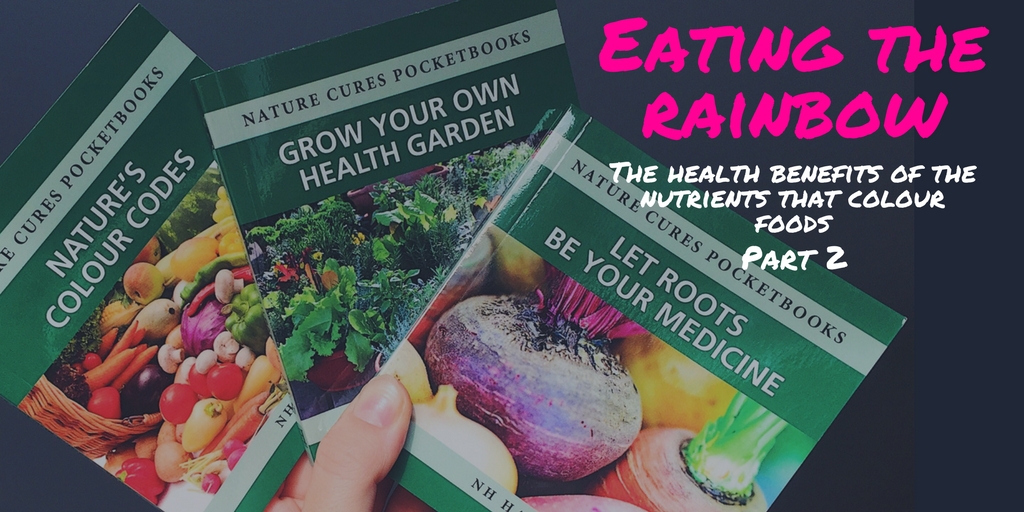
The following list of nutrients in foods, that produce their colours, is by no means complete as more are being discovered all the time. However, it provides the reader with some reasons why the consumption of colourful foods is vital for ultimate health.
Anthocyanins (blue to black)
Anthocyanins are a water-soluble bioflavonoid pigment and the colour will depend on the pH of the solution they are in. They are red when the pH is below three (highly acid), blue at pH ghihger than 11 (very alkali) and violet a neutral pH 7.
Bioflavoniods have been found to help slow down age-related motor changes, such as those seen in Alzheimer’s or Parkinson’s disease, prevent the oxidisation of certain compounds and fight attacks on the body from harmful chemicals.
They also increase vitamin C levels within cells, decrease the breakage of small blood vessels, protect against free-radical damage and help prevent destruction of collagen by helping the collagen fibres link together in a way that strengthens the connective tissue matrix. They also reduce blood glucose levels and improve insulin sensitivity due to the reduction of retinol-binding-protein-4 so are useful in preventing diabetes and can help with treating obesity.
Anthoxanthins (cream and white)
Anthoxanthins are water-soluble pigments which range from white or colourless to a creamy yellow and red, often in the petals of flowers. These pigments are generally whiter in an acid medium and yellower in an alkaline medium. Consuming foods rich in anthoxanthins has been found to reduce stroke risk, promote heart health, prevent cancer and reduce inflammation.
- Those undergoing treatment for complex corneal diseases, whose underlying eye health condition is caused or aggravated by inflammation, might find increased symptom relief by including more anthoxanthin-rich foods in their diets.
Astaxanthin (red)
Astaxanthin is the most powerful antioxidant to man and is capable of crossing the blood/brain barrier to protect the brain cells from free radicals. It also increases the activity of the liver enzymes that detoxify carcinogens and stimulates and enhances the immune system.
Betalains (orange and yellow and blue to black)
Betalains are found in the petals of flowers, but may colour the fruits, leaves, stems and roots of plants that contain them. Betalains are aromatic indole derivatives synthesised from the amino acid (building block of proteins) tyrosine. There are two categories, Betacyanins (red to violet) and Betaxanthins (yellow to orange). Betalains provide a higher antioxidant value than most other vegetables containing beta-carotene and have anti-inflammatory anti-cancer and detoxifying properties and support the making of red blood cells.
Health benefits of betaxanthins
- Stop the spread of cancerous tumours
- Prevent diseases of liver, kidney and pancreas
- Help reduce ulcers in the stomach
- Strengthen the lungs and immune system
- Improve vision and are good for treating eye redness
- Reduce pain after intense physical training and also menstrual pain
- Eliminate hard stools and prevent constipation
- Positively affect the colon
- Regulate high blood pressure
- Eliminate bad breath
- Help to treat acne and create healthy skin.
Health benefits of betaxanthins
- Can cross the blood-brain, eye and spinal barriers to help arrest free-radical damage in cell membranes, mitochondria and DNA
- Enhance immune cell strength and antibody activity
- Improve gastrointestinal health
- Improve cognitive function
- Help to maintain peak performance in athletes
- Protect the heart.
Carotenoids (deep green, yellow, orange and red)
The carotenoids are a group of more than 700 fat-soluble nutrients. Many are proving to be very important for health. They are categorised as either xanthophylls or carotenes according to their chemical composition. These compounds have the ability to inhibit the growth of many pre-cancerous tumours.
- Carotenoids act as antioxidants. Alphacarotene, betacarotene and cryptoxanthin are types of carotenoids, and the body can convert all of these to vitamin A which helps keep the immune system working properly and it is needed for eye health.
- Other types of carotenoids are lutein and zeaxanthin and, when consumed regularly, protect the retina from damage caused by the sun’s harmful UV rays and high-energy visible light. Lutein and zeaxanthin can also reduce the risk of cataracts later in life.
- These antioxidants also have the ability to protect cells and other structures in the body from the harmful effects of free radicals.
- Lutein can also help to reduce the risk of breast cancer and heart disease and supports healthy skin, tissue, blood and the immune system.
- Lycopene is the bright red carotenoid that is found in fruits and vegetables. Consuming lycopene regularly helps to reduce the risk of heart disease and stroke, cancers of the prostate, stomach, lungs and breast, and osteoporosis, and protects LDL cholesterol from oxidation, which prevents heart disease.
Chalcones (yellow), Chlorophyll (green), Curcumin (yellow), and Flavins (pale-yellow and green fluorescent) are further nutrients founds in foods that produce their colours. For more information on these nutrients, you can purchase the book here.
This extract was taken from “Nature’s Colour Codes” from the Nature Cures pocketbook series by Nat H Hawes.
